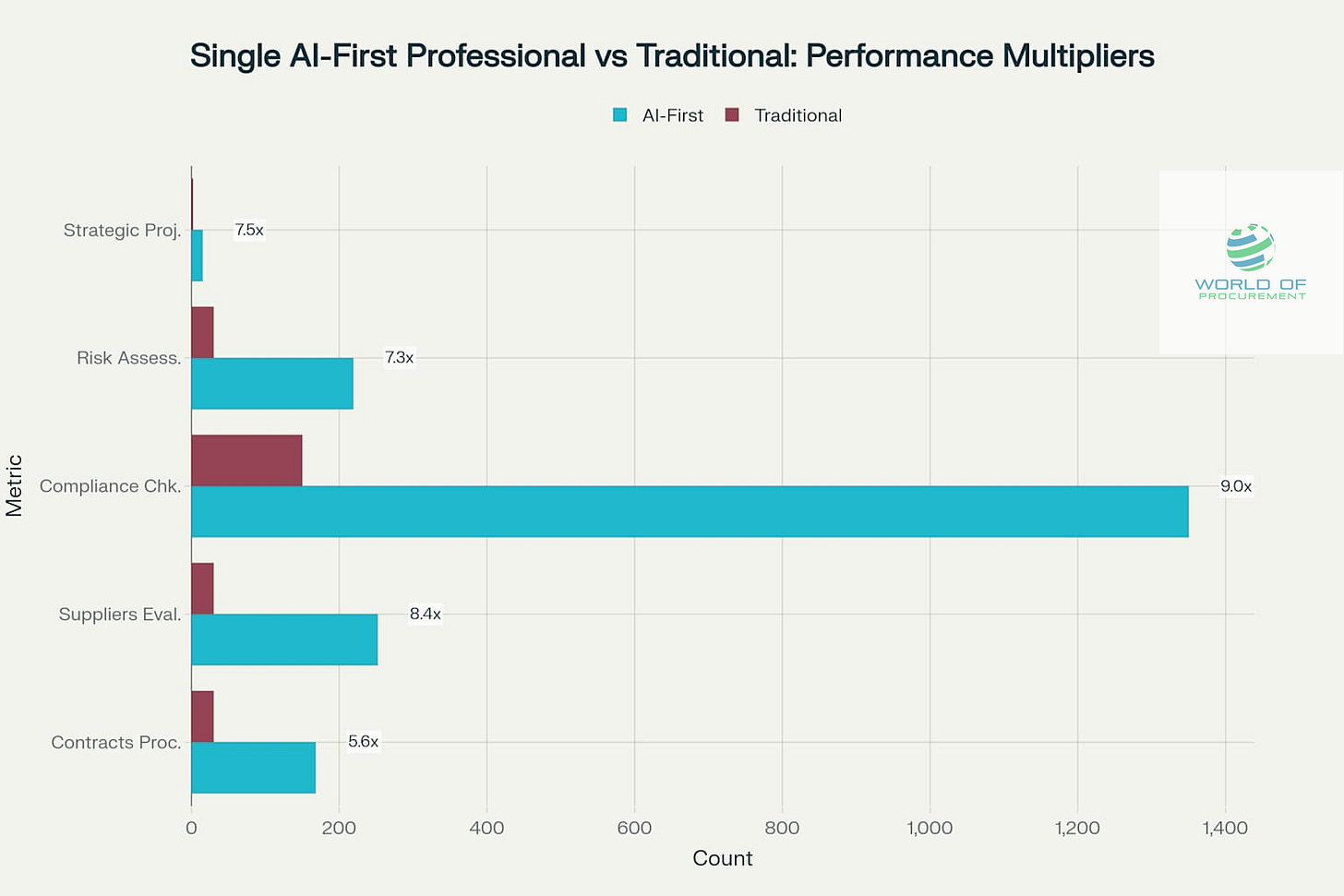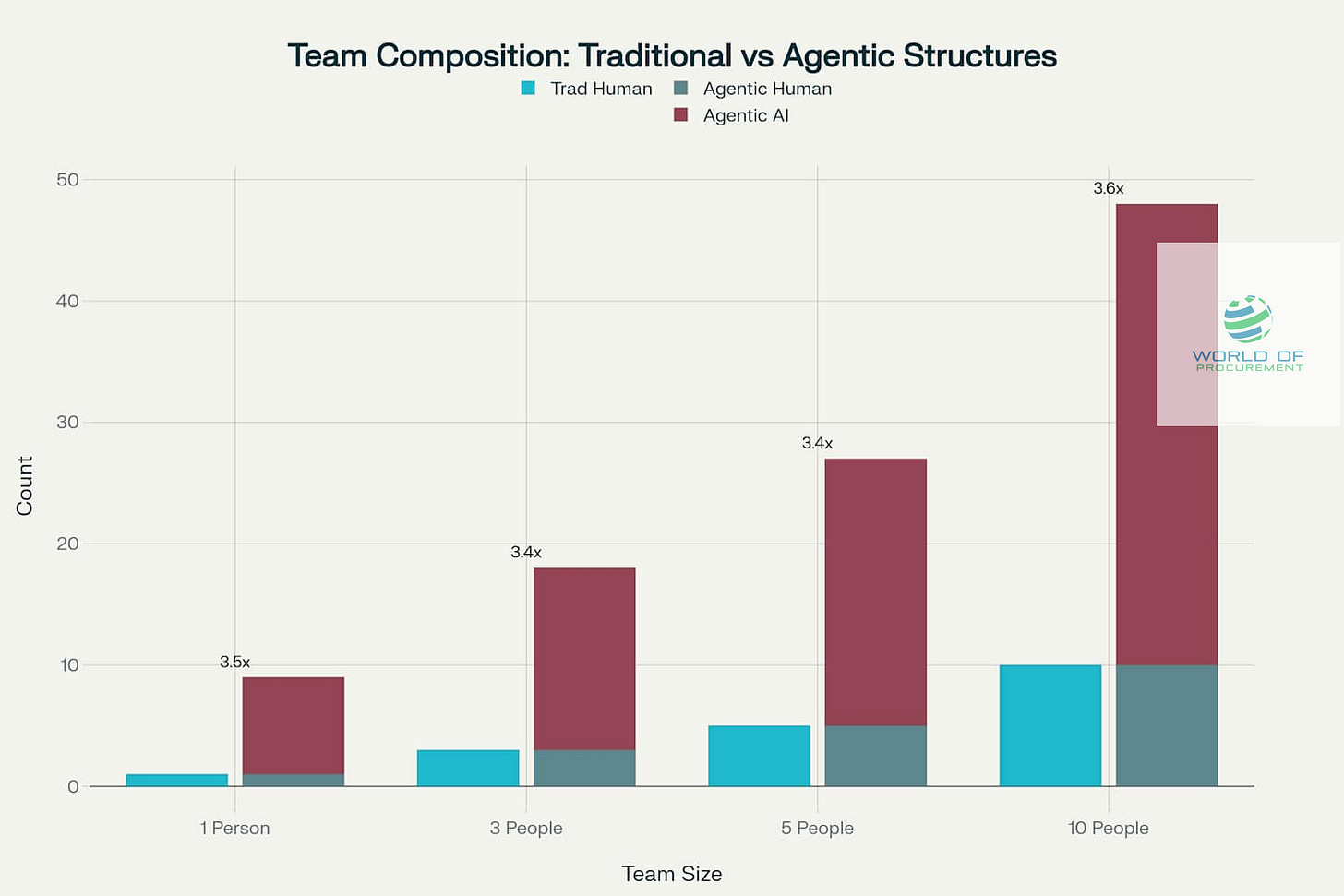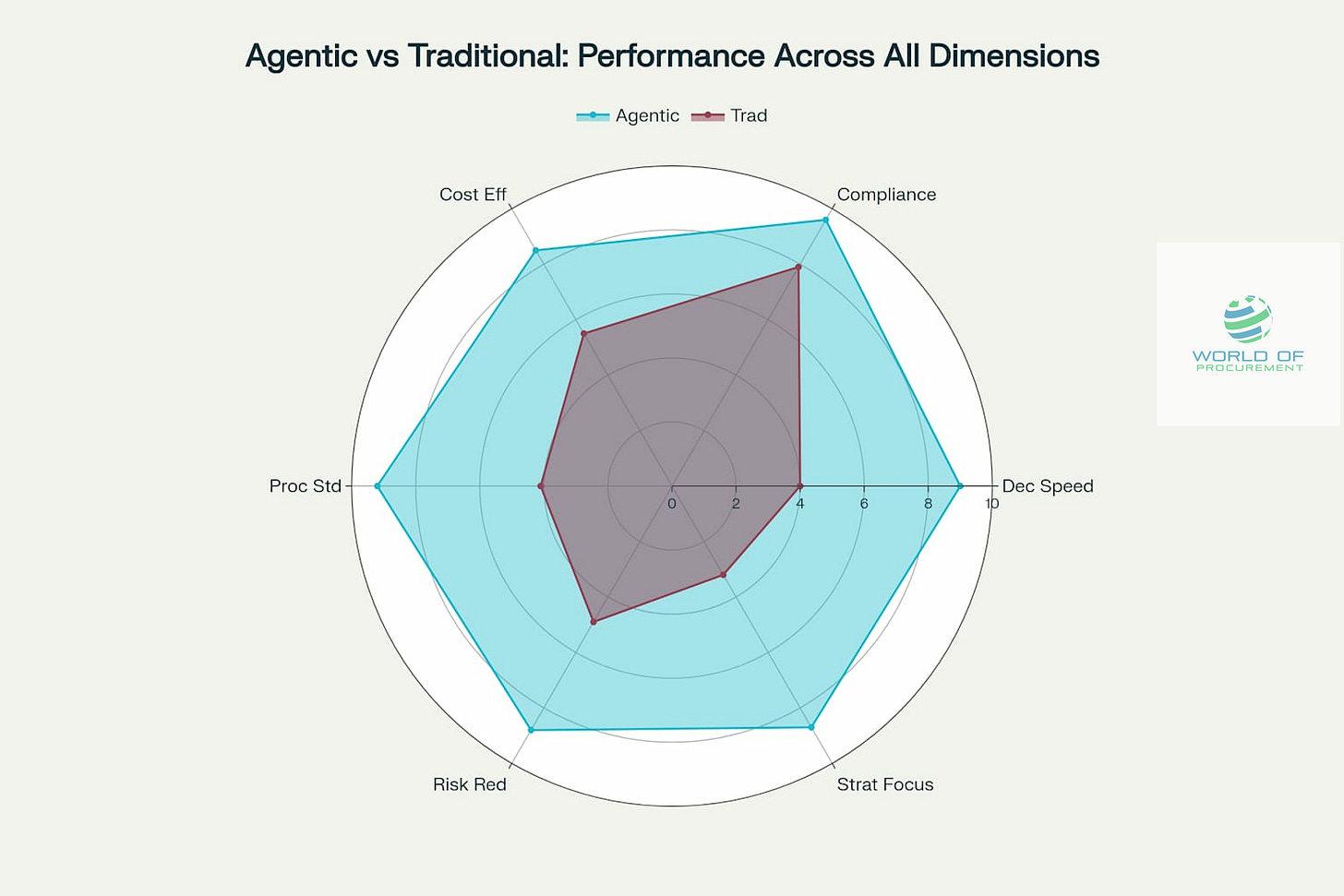The AI-First Procurement Revolution: Why One Smart Professional Beats Ten Traditional Ones
Don't sleep on this
The procurement world is experiencing its iPhone moment. Just as smartphones didn't just improve phones but replaced entire industries, AI agents aren't just making procurement faster; they're also transforming whole industries. They're fundamentally rewriting what's possible with human potential.
If you're still thinking about AI as an expensive add-on to your existing processes, you're missing the revolution happening right under your nose. The future belongs to AI-first procurement professionals who understand a simple truth: one strategically augmented human can outperform entire traditional teams.
The Embedded AI Reality: Why Costs Are Plummeting, Not Skyrocketing
Let me address the elephant in the room that's keeping procurement leaders awake at night: cost. The narrative that AI will break your budget is not just wrong but dangerously misleading.
Here's what's actually happening in the market: embedded AI capabilities are becoming standard features, not premium add-ons. At Gatekeeper, we're building agentic capabilities directly into our platform offering without massive price increases. This isn't unique to us, but the fundamental transformation of SaaS itself.

Traditional standalone AI tools are indeed expensive, with costs rising from $150K in 2023 to a projected $330K by 2027. But embedded SaaS AI capabilities are moving in the opposite direction, dropping from $50K to $30K over the same period. That's a $300K difference by 2027, making embedded AI not just functionally superior but economically essential.
The SaaS model is evolving from delivering tools that help you work faster to delivering outcomes through AI agents that work for you. If someone is charging you enterprise-level prices for basic AI capabilities, you're being fleeced. The smart money is on platforms that embed intelligence as a core feature, not an expensive bolt-on.
The David vs Goliath Reality: One AI-First Professional vs Ten Traditional Ones
This isn't theory but a measurable reality. A single AI-first procurement professional managing eight specialised AI agents can achieve 60% of a traditional 10-person team's annual spend management ($35M vs $58M) while being 9x faster in decision-making (2 days vs 18 days) and 51% more cost-effective ($28K vs $57K per million managed).

But here's where it gets really interesting: that single professional isn't just doing the same work faster but doing fundamentally different work. While traditional teams get bogged down in hierarchical approvals, manual compliance checks, and coordination overhead, the AI-first professional focuses on strategic decisions, relationship building, and value creation.
The performance multipliers are staggering, with single AI-first professionals achieving 5.6x more contracts processed monthly, 8.4x more suppliers evaluated, 9.0x more compliance checks completed, 7.3x more risk assessments conducted, and 7.5x more strategic projects delivered quarterly.
This isn't about replacing humans but amplifying human potential to levels that were previously impossible.
The Mid-Market Sweet Spot: Scaling from 1 to 10 People
Most mid-market procurement teams range from 1 to 10 people, with teams of 10 representing the upper bound, before you enter the early enterprise territory. The organisational implications across this range support a counterintuitive truth: smaller, AI-augmented teams consistently outperform larger traditional ones.

The Single-Person Powerhouse
The most compelling case study is the single-person AI-first structure. One procurement professional managing 8 AI agents achieves a 3.5x performance multiplier compared to traditional approaches. This person isn't drowning in administrative tasks but is freed to focus on strategic sourcing, supplier relationships, and business impact.
Scaling Patterns That Maintain Efficiency
As teams grow from 1 to 10 people, the agentic model maintains consistent performance advantages:
3-Person Team: Procurement Lead + Sourcing Lead + Contract Lead + 15 AI Agents = 3.4x improvement
5-Person Team: 5 Human Leads + 22 AI Agents (each human managing 4 to 5 agents) = 3.4x improvement
10-Person Team: Director + 9 Specialised Leads + 38 AI Agents = 3.6x improvement
The key insight? Performance multipliers remain consistent regardless of team size because the fundamental efficiency comes from the human-AI collaboration model, not just the technology itself.
The Flat Structure Advantage: Why Hierarchy Kills Speed
Traditional procurement structures create multiple layers of approval, handoffs, and coordination overhead that slow decision-making and reduce agility. In contrast, agentic structures maintain flat hierarchies where each human directly manages specialised AI agents.

The efficiency metrics are transformational: agentic teams maintain 2 to 5 day decision cycles compared to 8 to 18 days for traditional teams, achieve compliance scores of 95 to 98% versus 75 to 84% for traditional approaches, manage 3.5x higher annual spend capacity on average, and deliver 40 to 50% lower cost per million dollars managed.
These aren't marginal improvements but transformational advantages that compound over time as AI agents learn and optimise their performance.
Comprehensive Performance Analysis: Where Agentic Teams Excel
The performance advantages of agentic structures extend across every critical dimension of procurement operations, creating a comprehensive superiority that makes traditional approaches increasingly obsolete.

The radar analysis reveals that agentic teams outperform traditional structures across all six key dimensions: decision speed (9 vs 4), compliance scores (9.6 vs 7.9), cost efficiency (8.5 vs 5.5), process standardisation (9.2 vs 4.1), risk reduction (8.8 vs 4.9), and strategic focus (8.7 vs 3.2).
This comprehensive advantage means that organisations adopting agentic structures don't just improve individual processes but transform their entire procurement capability.
Building Your AI-First Procurement Career
Whether you're a procurement professional just starting out or a seasoned leader, transitioning to an AI-first mindset requires specific skills and mindsets. The procurement professionals who thrive in this new world will combine traditional expertise with new capabilities in AI management and strategic thinking.
Essential Skills for the AI-First Professional
Change Management: AI and automation are driving rapid change in procurement, and not everyone adapts easily. Even if you're not in a leadership position, you can drive change by demonstrating the benefits of new tools and processes.
Cross-Functional Collaboration: Procurement doesn't operate in a vacuum. Aligning procurement with finance, operations, and other business units ensures that sourcing strategies support overall business goals.
Cost Optimisation: This isn't just about cutting expenses, but also about finding more innovative ways to manage procurement budgets without sacrificing quality or efficiency. AI-powered spend analysis tools can highlight redundant expenses, unused subscriptions, and supplier overlaps.
The Technical Skills That Matter
You don't need to become a programmer, but understanding how to brief and manage AI agents is crucial for effective management. Prompt engineering is becoming as important as contract negotiation skills. The leaders who can turn hours of work into minutes through effective AI collaboration will have a significant advantage.
Consider learning platforms like Replit to start building your own AI agents and understanding the technical foundations of what you're managing. The "buy vs make" decision is essential, but understanding how these systems work gives you strategic advantages regardless of your implementation approach.
The Strategic Implications: What This Means for Your Organisation
The evidence strongly supports a strategic shift toward lean, AI-first procurement structures for mid-market organisations. Rather than building traditional hierarchical teams that require 5 to 10 people to achieve basic procurement capabilities, organisations can deploy 1 to 3 AI-augmented professionals to achieve superior outcomes at a lower cost.
This transformation aligns perfectly with the evolution of SaaS from tool provision to outcome delivery. Embedded AI capabilities enable small teams to access enterprise-level procurement intelligence, automation, and monitoring without the traditional resource requirements or ongoing operational complexity.
The Competitive Reality
Organisations that establish robust agentic procurement capabilities today will be better prepared to adapt to future regulatory changes and maintain a competitive advantage through superior compliance performance. The procurement profession itself is transforming as traditional task-oriented roles evolve into strategic positions focused on AI management, cross-functional coordination, and complex decision-making.
The future belongs to lean AI-fast teams that will crush traditional structures in capability. The performance advantages compound as AI agents can simultaneously monitor hundreds of suppliers, process thousands of compliance checks, and maintain continuous oversight without fatigue or inconsistency.
Your Next Steps: Becoming AI-First
Keep reading with a 7-day free trial
Subscribe to The AI Procurement Blueprint to keep reading this post and get 7 days of free access to the full post archives.




